I have questions on two types of Sunfish Hybrids: BG/RES hybrid and GSF/RES hybrid.
BG/RES hybrid: Can someone verify or correct my understanding of these hybrids please?
Size will be favorable as both RES and BG can attain 2+ lbs.
Hybrid will assume more aggressive nature of the BG making it easier to catch than RES
Will hybrid assume the RES benefit of foraging on parasitic organisms?
Do F1 hybrids backcross? Is this an inferior fish?
90% of all hybrids are Male. Is this correct?
Any other information available on these hybrids, their benefits or insight on roles they can play in a pond?
GSF x RES:
I have caught around a dozen of these and stocked them in my main pond - they were impressive in size, aggressive, and beautiful fish looked somewhat like a Pumpkinseed on steriods to my untrained eye.
I neglected to take photos of these fish - and am unable to find any online. Does anyone have photos of this hybrid they could provide?
Thanks in advance....
GSF X RES

At least that's how I imagine it. Never underestimate the ability of GSF DNA to foul things up.
And no, TJ, you don't even want to know what a GSF X SMB looks like, and yes, I think they're occurring in your pond as we speak. You should have known better than to WILLINGLY add GSF genetics to your pond!
GSF x SMB

Gosh, TJ, I hate to say it, but I think your kids are going to be real disappointed this summer!
Well, you should have known better, I make it a rule to keep my pond strictly "nonGMO", especially when it comes to GSF GMO.
That's about enough from both of you bullies. Don't you understand I'm trying to verify the value of the RES/BG hybrid so I can SELL them to both of you for $5/inch next Autumn? Jeesh! Now, I'm about letting bygones be bygones...let's get back to the task at hand. There seems to be some misunderstanding - when I say GSF I'm talking about the freshwater Green STARfish, not SUNfish.
You buying that?

90% of all hybrids are Male. Is this correct?
Not necessarily. Depending on the species and which individual is male or female will have influence on gender of the fish. Percentage of males can range from a little over 50% to up to 99% depending on the above items. I think there are "standard" photos of the RES hybrids available on this forum. I will see what I can find. ewest has a good inventory of fish pics. Keep in mind the pictures could be of male or female fish. Probably which species was male can probably affect the final coloration of the F1 individuals.
There is a good bit of info from studies on RES Xs and BG Xs. This could take years to go over all the info on lepomis genetics/speciation. Below BR= BG X RES while RB= Recp cross RES X BG.
HYBRIDIZATION OF FISHES IN NORTH AMERICA
(FAMILY CENTRARCHIDAE)
by
W.F. CHILDERS
Sex Ratios of F1 hybrids
Sexually mature F1 hybrids were collected from each population and sexed. Of the 10 kinds of viable F1 hybrids, seven were predominately males (RB, BR, and BG were 97 percent males; WG were 84 percent males; and RG, GB, and BW were approximately 70 percent males), two were approximately 50 percent males (GR and RW), and one was predominately female (GW was 16 percent males). Ricker (1948) determined the sex of 428 BR F1 hybrids in Indiana and found them to be 97.7 percent males.
Sex determination in sunfishes is very poorly understood. Bluegills, green sunfish, and their F1 hybrids apparently have 24 pairs of chromosomes, and the sex chromosomes are indistinguishable from the autosomes (Bright 1937). Bright also reported that the chromosomes are so similar in shape and size that he was unable to detect specific differences. Roberts (1964) found that red-ear, bluegill, and warmouth sunfishes each have 24 pairs of chromosomes; green sunfish from North Carolina had 24 pairs; but green sunfish from West Virginia had only 23 pairs.
The unbalanced phenotypic tertiary sex ratios of the F1 hybrid sunfish could result from unbalanced primary genetic sex ratios, specific differences in the strength of sex-determining factors, an overriding of the genetic sex by environmental factors, or differential mortality of the sexes.
Since the WG F1 hybrids were 84 percent males and the reciprocal cross hybrids were 16 percent males, it is possible that the strength of sex-determining factors of warmouths are 5.25 times more powerful than those of green sunfish. Specific differences in the strength of sex-determining factors cannot alone explain the sex ratios of the remaining eight kinds of viable hybrids, since none of these were predominately females.
RB and BG F1 hybrids were both 97 percent males. If differential mortality were the cause of these unbalanced sex ratios, much of the mortality would have had to occur after the swim-up fry stages, since in the stripping experiments total mortality between fertilization and the swim-up fry stages was only 14 percent for the RB and 27 percent for the BG F1 hybrids.
It is not known which sex is the heterogametic condition for the sex chromosomes of the four experimental species; however, Haldane (1922) formulated a rule which furnishes a clue: “When in the F1 offspring of a cross between two animal species or races, one sex is absent, rare, or sterile, that sex is always the heterozygous sex.” Using Haldane's rule, Krumholz (1950), in a study concerning BR F1 hybrids, pointed out that the males of both bluegills and red-ear sunfish are probably homozygametic for sex and the females heterozygametic. The application of Haldane's rule to all possible F1 hybrids produced from red-ear sunfish, bluegills, and green sunfish indicates that the female is the heterozygametic sex in these three species. Hybridization of male warmouths with females of the three Lepomis species resulted in partial or complete lethals, suggesting that in the warmouth the male is the heterogametic sex.
4.2 Reproductive success of hybrids
The reproductive success of each of the 10 kinds of viable F1 hybrids was investigated in one or more ponds. The occurrence and abundance of F2 hybrids were determined by seining, trapping, shocking, poisoning or draining the ponds after the F1 hybrids were one or more years of age. RB, BR, and BG failed to produce abundant F2 generations when in ponds which contained no other species of fishes. In contrast to these results, BR F1 hybrids produced abundant F2 generations in two ponds in Indiana (Ricker 1948). The other seven kinds of F1 hybrids produced abundant F2 populations when stocked in ponds containing no other fishes. Three of the seven kinds of F1 hybrids which produced large F2 populations when stocked in ponds containing no other fishes were also stocked in ponds with largemouth bass. RG F1 hybrids and GB F1 hybrids, when stocked with largemouth bass, produced only a few F2 hybrids. No F2 hybrids were found in the pond stocked with BW F1 hybrids and largemouth bass. WG F2 hybrids and GW F2 hybrids were stocked in ponds containing no other fishes. Both of these F2 hybrids produced large F3 populations.
Backcrosses, outcrosses, a four-species cross, and a three-species cross involving F1 hybrids are listed in Table III. The BW × B backcross was made by stocking adult male BW F1 hybrids and adult female bluegills in a pond which contained no other fishes. The other 12 crosses listed in Table III were made by stripping gametes from ripe adults and rearing the young to the free-swimming fry stage in the laboratory.
R × RW, W × RW, B × RW, G × RW, R × GB, and RB × W young were killed after they developed into free-swimming fry because of the lack of ponds in which they could be stocked. All six kinds of fry appeared to be normal and probably would have developed into adults. Free-swimming fry of the remaining six crosses in the laboratory were stocked in ponds and did develop into adult fishes. BW × B, G × GW, and B × RG populations produced large numbers of young.Sex Ratios of F1 hybrids
Sexually mature F1 hybrids were collected from each population and sexed. Of the 10 kinds of viable F1 hybrids, seven were predominately males (RB, BR, and BG were 97 percent males; WG were 84 percent males; and RG, GB, and BW were approximately 70 percent males), two were approximately 50 percent males (GR and RW), and one was predominately female (GW was 16 percent males). Ricker (1948) determined the sex of 428 BR F1 hybrids in Indiana and found them to be 97.7 percent males.
Sex determination in sunfishes is very poorly understood. Bluegills, green sunfish, and their F1 hybrids apparently have 24 pairs of chromosomes, and the sex chromosomes are indistinguishable from the autosomes (Bright 1937). Bright also reported that the chromosomes are so similar in shape and size that he was unable to detect specific differences. Roberts (1964) found that red-ear, bluegill, and warmouth sunfishes each have 24 pairs of chromosomes; green sunfish from North Carolina had 24 pairs; but green sunfish from West Virginia had only 23 pairs.
The unbalanced phenotypic tertiary sex ratios of the F1 hybrid sunfish could result from unbalanced primary genetic sex ratios, specific differences in the strength of sex-determining factors, an overriding of the genetic sex by environmental factors, or differential mortality of the sexes.
Since the WG F1 hybrids were 84 percent males and the reciprocal cross hybrids were 16 percent males, it is possible that the strength of sex-determining factors of warmouths are 5.25 times more powerful than those of green sunfish. Specific differences in the strength of sex-determining factors cannot alone explain the sex ratios of the remaining eight kinds of viable hybrids, since none of these were predominately females.
RB and BG F1 hybrids were both 97 percent males. If differential mortality were the cause of these unbalanced sex ratios, much of the mortality would have had to occur after the swim-up fry stages, since in the stripping experiments total mortality between fertilization and the swim-up fry stages was only 14 percent for the RB and 27 percent for the BG F1 hybrids.
It is not known which sex is the heterogametic condition for the sex chromosomes of the four experimental species; however, Haldane (1922) formulated a rule which furnishes a clue: “When in the F1 offspring of a cross between two animal species or races, one sex is absent, rare, or sterile, that sex is always the heterozygous sex.” Using Haldane's rule, Krumholz (1950), in a study concerning BR F1 hybrids, pointed out that the males of both bluegills and red-ear sunfish are probably homozygametic for sex and the females heterozygametic. The application of Haldane's rule to all possible F1 hybrids produced from red-ear sunfish, bluegills, and green sunfish indicates that the female is the heterozygametic sex in these three species. Hybridization of male warmouths with females of the three Lepomis species resulted in partial or complete lethals, suggesting that in the warmouth the male is the heterogametic sex.
4.2 Reproductive success of hybrids
The reproductive success of each of the 10 kinds of viable F1 hybrids was investigated in one or more ponds. The occurrence and abundance of F2 hybrids were determined by seining, trapping, shocking, poisoning or draining the ponds after the F1 hybrids were one or more years of age. RB, BR, and BG failed to produce abundant F2 generations when in ponds which contained no other species of fishes. In contrast to these results, BR F1 hybrids produced abundant F2 generations in two ponds in Indiana (Ricker 1948). The other seven kinds of F1 hybrids produced abundant F2 populations when stocked in ponds containing no other fishes. Three of the seven kinds of F1 hybrids which produced large F2 populations when stocked in ponds containing no other fishes were also stocked in ponds with largemouth bass. RG F1 hybrids and GB F1 hybrids, when stocked with largemouth bass, produced only a few F2 hybrids. No F2 hybrids were found in the pond stocked with BW F1 hybrids and largemouth bass. WG F2 hybrids and GW F2 hybrids were stocked in ponds containing no other fishes. Both of these F2 hybrids produced large F3 populations.
Backcrosses, outcrosses, a four-species cross, and a three-species cross involving F1 hybrids are listed in Table III. The BW × B backcross was made by stocking adult male BW F1 hybrids and adult female bluegills in a pond which contained no other fishes. The other 12 crosses listed in Table III were made by stripping gametes from ripe adults and rearing the young to the free-swimming fry stage in the laboratory.
R × RW, W × RW, B × RW, G × RW, R × GB, and RB × W young were killed after they developed into free-swimming fry because of the lack of ponds in which they could be stocked. All six kinds of fry appeared to be normal and probably would have developed into adults. Free-swimming fry of the remaining six crosses in the laboratory were stocked in ponds and did develop into adult fishes. BW × B, G × GW, and B × RG populations produced large numbers of young.
Thanks Eric and Bill...this is good scientific research - good information - seems they cross possibilities are pretty vast. I'm planning on crossing Male CSBG and Female RES...Has anyone done a study on the habits of the RESxBG hybrid, know it's effect on a pond, or overall desirability of a panfish? If anyone knows where to point me in the right direction I would be appreciative.
I'll bet that THEO still has a photo saved of an awesome BG-RES hybrid from a northern widwestern Great Lakes state pondmeister. Cant remember exactly who.
TJ,
I get in redear bluegill hybrids to mount from the local public lakes from time to time. They are natural and not planted. I do know they have the crusher teeth the redears do.
Interesting articles and I particularly liked the first one. They claim that GSF, in the South, have multiple spawns. I didn't know that.
Cecil, keeping the crusher teeth is a pretty neat hybrid adaptation. I like that.
Interesting articles and I particularly liked the first one. They claim that GSF, in the South, have multiple spawns. I didn't know that.

Sorry to enterrupt your Muhaaa, but I wonder if the RES/BG hybrid crushers are based on one parent species being male or female?
Interesting articles and I particularly liked the first one. They claim that GSF, in the South, have multiple spawns. I didn't know that.
Not in my pond. I insist they use pondoms.
Interesting articles and I particularly liked the first one. They claim that GSF, in the South, have multiple spawns. I didn't know that.
Not in my pond. I insist they use pondoms.
Yolkie, please. It's still early!
Interesting articles and I particularly liked the first one. They claim that GSF, in the South, have multiple spawns. I didn't know that.
Not in my pond. I insist they use pondoms.
I must admit Yolk, that is one of the funnier lines that I have read here.
I'll bet that THEO still has a photo saved of an awesome BG-RES hybrid from a northern widwestern Great Lakes state pondmeister. Cant remember exactly who.
Theo, you still got that screen saver?
Intra- and interspecific crosses involving green sunfish (Lepomis cyanellus) and redear sunfish (L. microlophus) were made to produce progeny of each parental species and reciprocal hybrids. The differences in growth rates of different progeny classes were determined and related to their differences in tissue enzyme activities. After one growing season, redear female × green male hybrids showed the greatest growth (average weight gain) followed by that of green female × redear male hybrids, redear and green sunfish. At the end of the second growing season, green female × redear malehybrids had the highest average weight followed by redear female × green male hybrid, redear and green sunfish. Specific activities of different enzymes (malate dehydrogenase, lactate dehydrogenase, glucosephosphate isomerase and phosphoglucomutase) in one or more tissues (skeletal muscle, liver, and eye) also differed among the progeny classes. No significant correlation was observed between growth and the tissue levels of enzyme locus expression. Enzyme activity levels of hybrids tended to be intermediate to those of parental species, whereas growth rates of each hybrid exceeded parental growth rates. Apparently, alterations of gene regulation in the hybrids are exerting different effects upon these morphological and molecular traits.
Couldn't find a pic either.

burger, you thinkin this one?
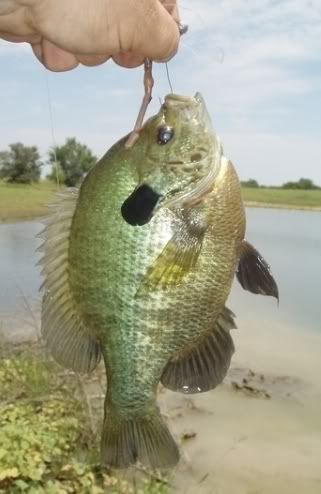
i recall stealing that pic from bruce.
That is one according to the person who posted it - not Bruce.
I think it came from Duckbutt.
http://www.pondboss.com/forums/ubbthreads.php?ubb=showflat&Number=56975&fpart=1
Thanks Eric!! This contained some useful information.
TJ,
I get in redear bluegill hybrids to mount from the local public lakes from time to time. They are natural and not planted. I do know they have the crusher teeth the redears do.
Existence of pharyngeal teeth would suggest they also would target parasitic critters - a beneficial trait IMO that carries over after hybridization.
Yes, I googled pharyngeal teeth
Time was, that'd get you tarhh'd and feathu'd. Pep'ridge Fahm remembuhs.
What are these?


These seem, to my uneducated eye, to have the characteristics of the RES and GSF. The website I got them from that Travis
linked to in another thread calls them pumpkinseeds, but that can't be right. They look nothing like the pumpkinseeds in this
thread.
My RESxGSF hybrids looked a lot like these, but the gape isn't there for these to be hybrids - is it? I can't believe we can't seem to wrestle up some pix of RESxGSF hybrids...I guess I'm going to have to catch these guys this Spring and post the pics.
Yeah, you're right. That got by me. But I don't think they're pumpkinseeds either.
What are these?


These seem, to my uneducated eye, to have the characteristics of the RES and GSF. The website I got them from that Travis
linked to in another thread calls them pumpkinseeds, but that can't be right. They look nothing like the pumpkinseeds in this
thread.
Those are pumpkinseeds. What about them makes you think they aren't? Remember there is a lot of seasonal and regional variance in coloration among all sunfish species including PS.
One I caught this past summer in NC.

Yeah, you're right Travis. Upon further review...

I don't think there is any GSF in those two fish, no white margins on the tail or anterior edge of the dorsal/anal fins. I think they're PSK/RES cross. I say cross because of the vertical dark banding that is apparent in the pics.
I would guess PS. I don't see anything else there.
From the picture, I don't think the top fish is a a pure PS, plus the coloration is not what I typcially see in PS which does not really mean much due to the wide variation in fish coloration.
I base my comment on the length of the pectoral fins. The pectoral fin should be the same length for a male and female of the same species of Lepomis. Note the pectoral of bottom fish & CJ's PS reaches past the posterior pelvic fin and to or just about to the base of the anal fin in both fish. As I look a second and third time, more closely at the PS fins, I think the pectoral fin, if laid straight back, will actually reach the base of the anal fin. Look closely for the fine pointed pectoral fin tip in both of the the PS. Whereas the back tip of the pectoral of top fish does not quite reach the pelvic tip or go past the posterior pelvic and in no way comes close to the base of the anal fin. This can be hard to measure on a picture but in this case it is fairly clear at least to me - maybe not to all.
Also notice that the back tip of the pelvic fin reaches within about or at least 1/4" of the base of the anal fin in both of what I am calling PS. But in the top fish this distance is at least 1/2"-3/4" or more. This fin distance feature is a consistant feature for individuals of the same species and a good indication that the two with different fin rations are different species. Or the top fish could be a hybrid.
Since the pectoral fin is not as long as it should be in the top fish and coloration is not what I normally see in a pure PS I conclude it is some sort of hybrid because it does have some PS (or maybe RES) coloration and features.
Bill look at the different features of these 2 positively id PS from Wisc Fish. What do you see as it relates to the pics above ?Pics from Wisc Fish.
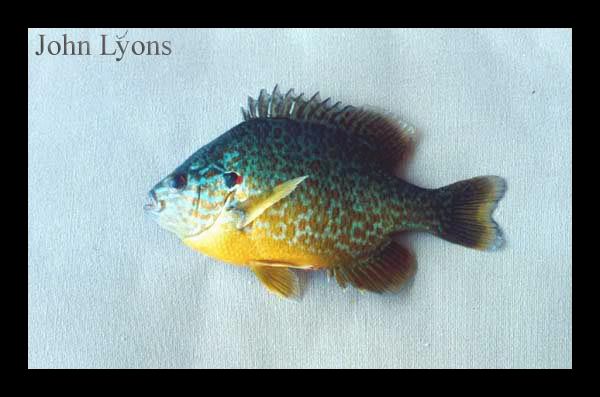
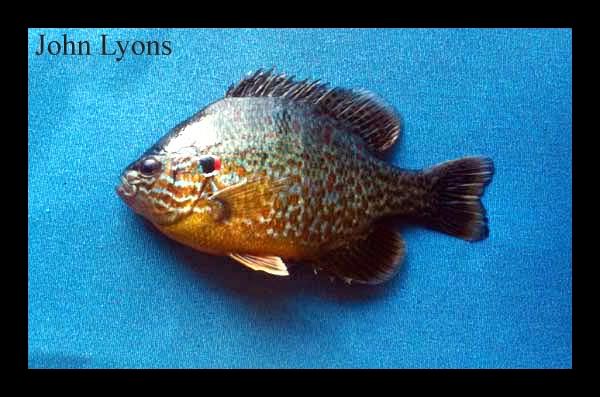
The pectorial back delicate, narrow tip or end is very hard to see in the bottom pic, but clearer in the top pic. In top fish if fin is laid straight back it will definately reach beyond the pelvic fin and quite close to or to the first spine of the anal fin. If the pectoral fin was well colored on 2nd fish as 1st fish, I think pectoral fins of both fish in the two Lyon's pics would have the same measurement ratios.
Notice in the top fish, the collapsed pelvic fin reaches close and within abt 1/4" of the anal fin base (not a 1/2"-3/4" distance) - similar to earlier pics of what I called PS.
Note I don't think one can use this pectoral fin feature to separate PS and RES. Both have very long pectoral fins. Actually I think the RES pectorial fin is longer in RES compared to PS. Not sure about the distance between the pelvic fin and anal base for RES. BG also have relatvely long pectorial fins but typically not quite as long as RES or PS.
All this stuff can be hard to see in pictures. It is easier to see and measure with a fish in your hand.
IMO ewest or someone else also with talent should add one of the above fresh/live specimen PS pics to the PS section of the PBoss Archive thread of Sunfishes:
http://www.pondboss.com/forums/ubbthreads.php?ubb=showflat&Number=92482#Post92482.Both of the PS in Lyon's pics are dying or dead due to the posterior margin, vertical discoloration of the caudal fin.
As I look at both PS pics of Omaha and CJ, I think Omaha's fish is a female and CJ's is a male - My $0.02
Sorry to enterrupt your Muhaaa, but I wonder if the RES/BG hybrid crushers are based on one parent species being male or female?
Don't know Burger. By the time I get them they are dead so I can't ask them, "Who's your daddy?"

Sorry to enterrupt your Muhaaa, but I wonder if the RES/BG hybrid crushers are based on one parent species being male or female?
Don't know Burger. By the time I get them they are dead so I can't ask them, "Who's your daddy?"

Now I dont care what side of the political spectrum you are on. "that's funny"!

Bill - as requested. See if it is what you want.

I think this is a RES X BG
Thanks for sharing Stump...I'm looking for a little orange or red on the ocular tab - should it be there to indicate RES genes? Anyone?
Generally, any evidence of a non-black, thin postmarginal gill flap membrane will positively indicate "extra" or added genetics from something other than bluegill. There is probably a point of hybrid genetic influence (No. of Chromosomes or amount of DNA) where the back margin of the gill flap goes from pure black in pure BG to someting other than black. I suppose a perfectly pure bluegill looking fish could have a "hint" non-BG genetics that is not outwardly apparent. It probably all depends. There are a few sunfish species (longear & redbreast for two) that also have a pure black gill flap, but these are typically rare in ponds.
orange or red on the ocular tab - should it be there to indicate RES genes? Anyone?
_________________________
Not necessarily. See the pic near the first of this thread.
Well, I guess it might all depend on the more dominant gene. They don't call them RES for nothin'!
GSF X RES

Kinda hard to see the ear tab on this one Eric.....

"evidence of a non-black, thin postmarginal gill flap membrane will positively indicate "extra" or added genetics from something other than bluegill"
Thanks Bill and Eric - this is helpful for me to bear in mind in the future.
It had red on it, you just can't see it in the pic. I caught several of these and pure BG and RES off of the same beds last year.
Cool stumpy...you have natural hybrids! I am trying to accomplish the same - care to share details on your pond?
I think the easiest way to produce natural hybrids besides putting all males of one species and all females of another species together is through nest crowding. If your pond has very minimal spawning habitat for sunfish, all the sunfish in your pond will be competing for that much less real estate. This can cause nests to be built that much closer together. IME with RES, they tend to nest on the edge of BG nest colonies. If they get jammed that much closer together, some milt from a male is going to drift over the eggs of a different species of sunfish. There are other factors involved as well, more turbid conditions can lead to mates having improper identification being one of them.
The odds against natural hybridization of different species are staggering when you figure that 99.9% of the eggs laid never make it to maturity. But, somehow, a few of them seem to make it.
Do the RES x GSF act different and feed on other items?
Just wondering if they would be easier to catch or how large these would get?
Do the RES x GSF act different and feed on other items?
Do they act differently than what?
Just wondering if they would be easier to catch or how large these would get?
Easier to catch than what? You could expect this type of hybrid to reach 2 pounds+ but 1 pound max would be far more reasonable.
Sorry I was not clear I wanted to know if the RES X GSF was much different from either the Pure GSF or Pure RES?
Okay boys - had a breakthrough tonight.
Was fishing the main pond tonight with BC, Matt Harris and his son, Sam. Sam caught several YP up to 12", and we managed some SMB up to 12 and some decent BG. Then Matt landed the fish that inspired this post over 6 mos ago...I've been trying for the last few months without success.
Sorry about the photos - a little blurry - still getting used to my new pond camera. It has the gape of a GSF, but the orange opercular tab of a RES or PS. The body of water from which this was caught has no BG but does have a strong RES population. My thought is somehow GSF were introduced and this is a RES/GSF hybrid. Might there also be some BG genetics? As my initial post indicates, I transported and stocked around a dozen of these [Yes, I intentionally introduce GSF genetics into my pond :o] and have been hoping to catch one again to provide the experts for positive ID.
If this is indeed a GSF/RES hybrid, as far as I know this is the only documentation I've been able to find on the forum, or the entire web for that matter. Thanks to Matt for the catch!
Cody, Eric, Dr Willis...any ideas or are these pix too blurry to allow positive ID?
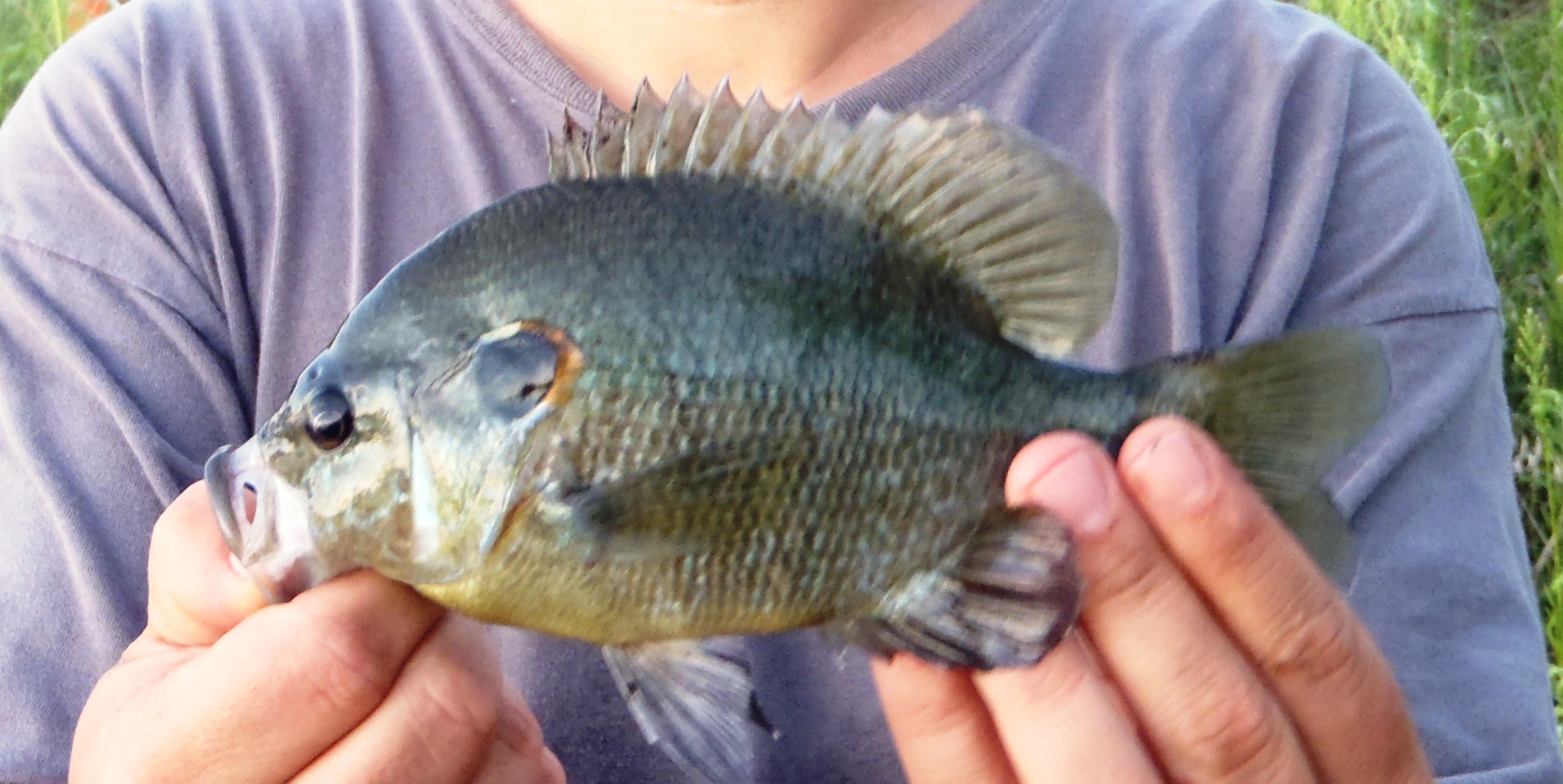
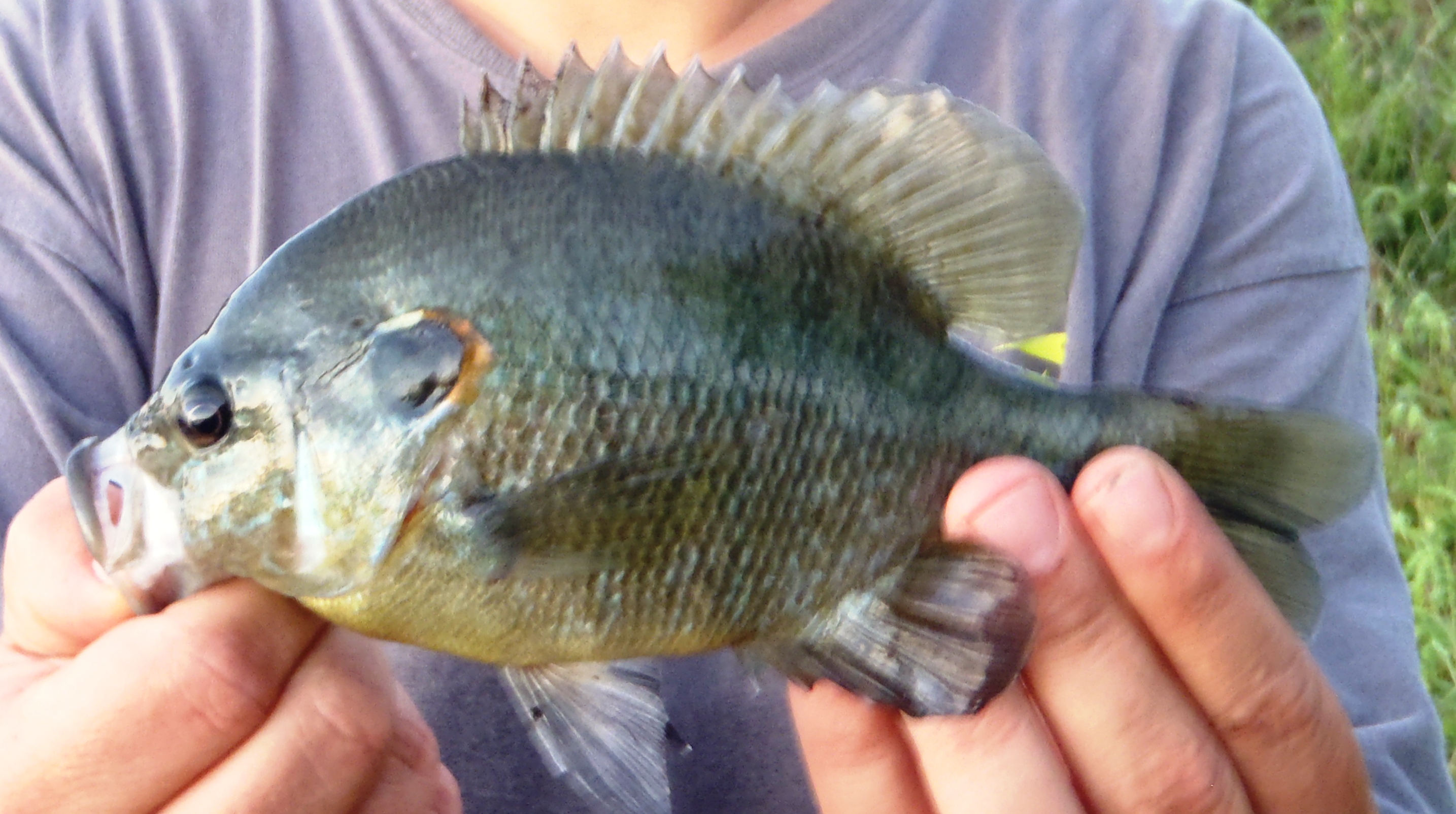

Could you see about getting a photograph of one these possible GSFxRES hybrid's gill rakers?
As my initial post indicates, I transported and stocked around a dozen of these [Yes, I intentionally introduce GSF genetics into my pond :o] and have been hoping to catch one again to provide the experts for positive ID.
I congratulate you on your wisdom and valor.
I take back 11 of the 37 bad things I've said about you.

No worries TJ as to Jhaps reduction...I added 15 new bad things about you.

Were the smallies you caught the ones I delivered to you? Any catches on the Hybrid Crappie?
SMB are up to 12" footballs - yes they are all the ones you delivered. I'm going to do an official post of my BC crappie, SMB and the SMB reproduction pond soon.
Many of the SMB are pellet trained. I am blown away at their rapid growth. The big boys have adopted the HSB pelagic tendencies and cruise way out along with the largest YP waiting for 600 pellets. Look/sound like M80's when they feed. I giggle like a little boy.
TJ are you saying that you put only RES and GSF in the pond or RES and hybrids (like shown) in the pond?
Sorry for the confusion.
One year ago I caught these hybrids while fishing for RES in a lake out in Western NE. The only panfish I have ever caught there have been RES, no BG or GSF. When I caught this fish, I couldn't identify it, so I decided to bring it home and stock in my pond. I was hoping to catch them again, photograph, and post on the forum for ID help.
I've looked everywhere for info/images of RES/GSF hybrids and have never found any for comparison. I thought it would be useful to provide these images for our archives - too bad they're of poor quality.
The gape, aqua/electric blue stripes on the opercular flap and the classic spazz-twitch when they are held made me think GSF. The orange border on the opercular tab made me think RES - also because it's from a lake dominated by RES.
I hope this makes more sense. Any guesses as to the genetics of this fish?
I can understand the confusion. That fish has attributes of all 3 fish species BG , GSF and RES. GSF can have that type ear tab with color. The pectoral fins look like part BG and part RES but not GSF. The bar pattern is BG while the head coloration is GSF. Dorsal fin is shaped like a RES. Body color and shape is BG ish. Mouth size is GSF.
Thanks Eric - so you're thinking it's a multi species hybrid - BG, RES and GSF?
When you catch another, pull a gill flap back and photograph the gill rakers, that will go a long way to properly IDing what hybrid it is...
I'll call Matt an ask him to catch another one...I've been trying all year without success! I will figure this new camera out and try to get better photos.
I did not address PS as I did not think they were in the source pond.
Gill rakers will help (for sure get a pic of them) but they too can be just as confused especially without a comparison to the base fish in the pond.
Gill rakers will help (for sure get a pic of them) but they too can be just as confused especially without a comparison to the base fish in the pond.
Ewest, can you explain this statement (in easy to understand one syllable words that even a bean counter can understand)?
Are you saying that gill rakers of a given species can very pond to pond? Or am I reading too much into this statement.
(Years of reading tax code and trying to interpret between the lines has muddled my already cloudy and somewhat demented cranial contents).
Here's a better photo...not sure if it helps or not:

Looking at gill rakers is hard enough with all the info in front of you (something to compare with at a minimum is needed). That is true even with pure species. Yes pure species vary based on local conditioning. The major morphological traits don’t vary as much but yes some. If you are looking at mix species - good luck. For instance does anyone know if the GSF trait for 9-12 short and thick primary gill rakers on the 1st arch or the BG trait of 13-16 moderately long primary gill rakers on the 1st arch is genetically transferred to HBG ( GSF x BG). Answer is the hybrid of GSF X BG has an intermediate appearance of gill rakers .What if it’s a 3 way cross ( HBG X RES). Now to even make it more difficult if a hybrid like TJ’s has 9-12 short and thick primary gill rakers on the 1st arch is it from a GSF or a PS each of which have that trait. Experience and something (its relatives) to compare with can only help in the guess work.
boy thats a neat one.
I'm watching the post curiously.
Thanks for posting -










